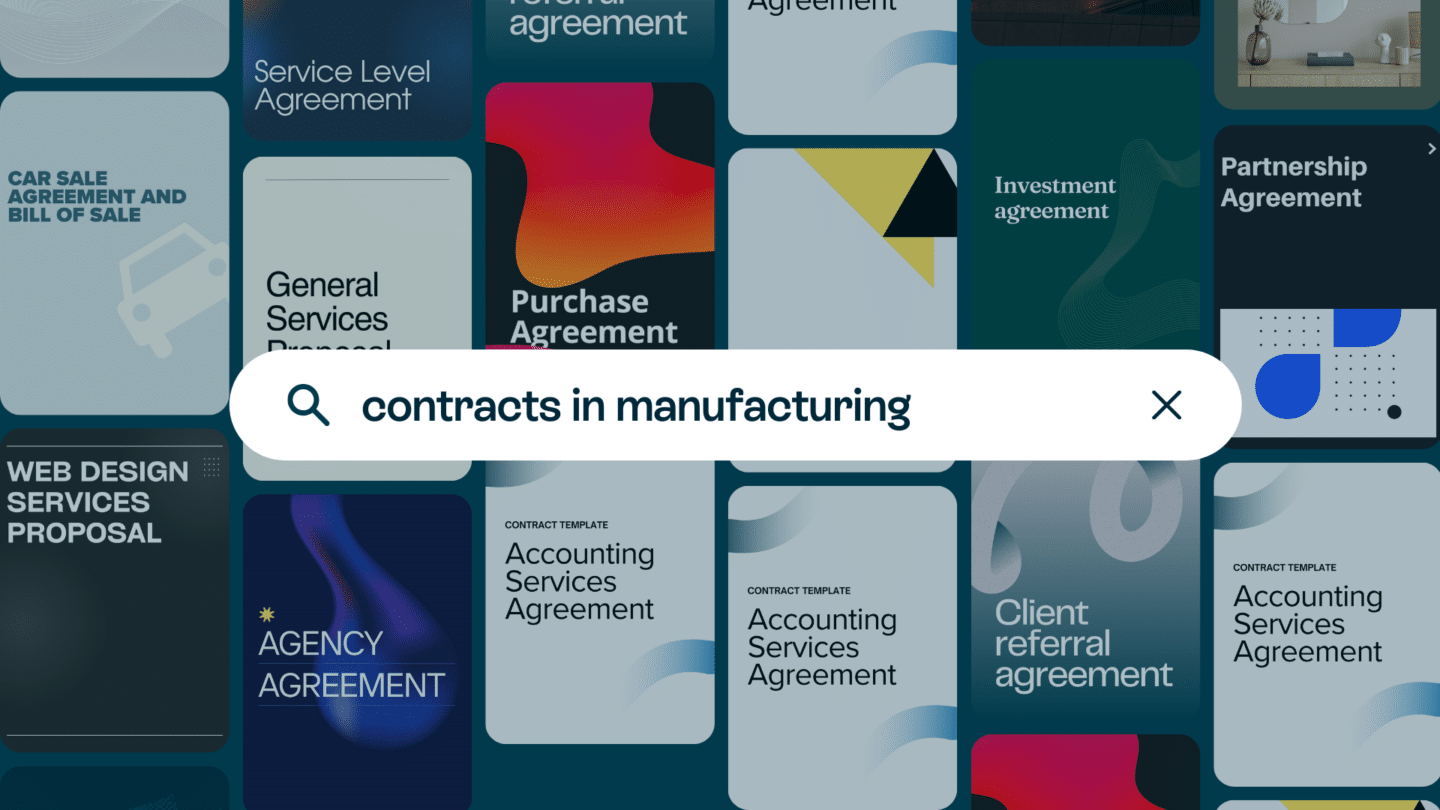In any manufacturing industry, precision and efficiency are essential. While manufacturers invest heavily in optimizing their production lines, many overlook the inefficiencies in their paperwork. Digitizing contracts in the manufacturing industry can save time, reduce errors, and enhance collaboration. Below, we explore the top 20 types of contracts in manufacturing, explaining their purpose, key counterparties, importance, and example scenarios where they are typically signed.

1. Supply Agreements
- What are they? Contracts between manufacturers and suppliers for the delivery of raw materials, components, or products.
- Counterparties: Manufacturers and suppliers.
- Why are they important? They ensure consistent material supply, prevent production delays, and define delivery schedules, quality standards, and payment terms.
- Example scenario: A manufacturer signs a supply agreement with a steel provider to ensure timely deliveries for automotive production.
2. Vendor Agreements
- What are they? Contracts outlining terms with third-party service providers or suppliers.
- Counterparties: Manufacturers and vendors.
- Why are they important? They clarify expectations, pricing, and timelines for services like maintenance or logistics.
- Example scenario: A factory signs a vendor agreement with a machinery maintenance company for regular equipment servicing.
Read also: How to sign contracts online?
3. Purchase Orders (POs)
- What are they? Legal documents confirming a purchase between the buyer and supplier.
- Counterparties: Manufacturers and suppliers.
- Why are they important? They formalize orders, ensuring clear communication and accountability.
- Example scenario: A manufacturer issues a PO to a supplier for a bulk order of electronic components.

4. Sales Agreements
- What are they? Contracts for selling manufactured goods to customers or distributors.
- Counterparties: Manufacturers and buyers (wholesalers, retailers, or distributors).
- Why are they important? They define the terms of sale, pricing, and delivery.
- Example scenario: A manufacturing company signs a sales agreement with a distributor for exclusive rights to sell its products in a specific region.
5. Distributor Agreements
- What are they? Contracts between manufacturers and distributors for product distribution.
- Counterparties: Manufacturers and distribution companies.
- Why are they important? They establish roles, responsibilities, and revenue-sharing terms.
- Example scenario: A manufacturer signs a distributor agreement with a logistics company to sell products across Europe.
6. Export Contracts
- What are they? Contracts for exporting goods internationally.
- Counterparties: Manufacturers and international buyers or distributors.
- Why are they important? They address customs, taxes, and compliance with international trade laws.
- Example scenario: A furniture manufacturer signs an export contract to ship products to a retailer in Asia.
Read also: What is contract management? A complete guide in 2025
7. OEM Agreements
- What are they? Original Equipment Manufacturer agreements for supplying components or products to other manufacturers.
- Counterparties: Manufacturers and OEM partners.
- Why are they important? They ensure compatibility, quality, and delivery schedules.
- Example scenario: A company supplying specialized car parts signs an OEM agreement with a leading automobile manufacturer.
8. Reseller Agreements
- What are they? Contracts permitting a third party to resell products.
- Counterparties: Manufacturers and resellers.
- Why are they important? They outline pricing, marketing rights, and territories.
- Example scenario: A manufacturer of industrial tools signs a reseller agreement with a local hardware chain.
9. Employment Contracts
- What are they? Agreements between employers and employees.
- Counterparties: Manufacturers and workers.
- Why are they important? They formalize roles, responsibilities, and compensation.
- Example scenario: A factory hires a production manager and signs an employment contract detailing their duties and benefits.

10. Union Agreements
- What are they? Collective bargaining agreements with labor unions.
- Counterparties: Manufacturers and unions.
- Why are they important? They ensure fair wages, benefits, and working conditions.
- Example scenario: A union and factory owner agree on a new wage structure and work hours.
11. Consulting Agreements
- What are they? Contracts for hiring external experts or consultants.
- Counterparties: Manufacturers and consultants.
- Why are they important? They bring expertise to solve specific challenges or optimize processes.
- Example scenario: A manufacturer signs a consulting agreement with a lean manufacturing expert.
Read also: What are digital signatures? A complete guide
12. Non-Disclosure Agreements (NDAs)
- What are they? Contracts protecting confidential information.
- Counterparties: Manufacturers and employees, vendors, or partners.
- Why are they important? They safeguard trade secrets and sensitive data.
- Example scenario: A manufacturer signs an NDA with a supplier before discussing proprietary production methods.
13. Maintenance Contracts
- What are they? Agreements for regular equipment servicing and repair.
- Counterparties: Manufacturers and maintenance providers.
- Why are they important? They ensure machinery uptime and prevent costly breakdowns.
- Example scenario: A factory signs a maintenance contract with a local machinery repair service.
14. Logistics Agreements
- What are they? Contracts for transportation, warehousing, and shipping services.
- Counterparties: Manufacturers and logistics providers.
- Why are they important? They enable smooth supply chain operations.
- Example scenario: A manufacturer signs a logistics agreement with a freight company for global product distribution.
15. Lease Agreements
- What are they? Contracts for renting factory spaces, warehouses, or equipment.
- Counterparties: Manufacturers and property or equipment owners.
- Why are they important? They provide access to essential resources without large upfront costs.
- Example scenario: A manufacturer leases a larger warehouse to accommodate increased production.
16. Service Level Agreements (SLAs)
- What are they? Contracts defining service standards for IT or infrastructure.
- Counterparties: Manufacturers and service providers.
- Why are they important? They ensure accountability and high performance.
- Example scenario: A factory signs an SLA with a cloud ERP provider.
17. Insurance Contracts
- What are they? Policies covering liability, property, or employee safety.
- Counterparties: Manufacturers and insurance companies.
- Why are they important? They mitigate risks and protect assets.
- Example scenario: A factory signs an insurance policy covering damages caused by fires.

18. Waste Disposal or Recycling Contracts
- What are they? Agreements for managing industrial waste.
- Counterparties: Manufacturers and waste management companies.
- Why are they important? They ensure environmental compliance and sustainability.
- Example scenario: A manufacturer partners with a recycling company for scrap metal disposal.
19. Licensing Agreements
- What are they? Contracts granting rights to use intellectual property or technology.
- Counterparties: Manufacturers and licensors.
- Why are they important? They facilitate innovation and competitive advantages.
- Example scenario: A factory licenses a patented production method for increased efficiency.
20. Joint Venture Agreements
- What are they? Contracts for collaboration on new ventures or projects.
- Counterparties: Manufacturers and partner companies.
- Why are they important? They enable resource sharing and risk reduction.
- Example scenario: Two manufacturers sign a joint venture agreement to develop a new product line.
Conclusion
Digital transformation in the manufacturing industry goes beyond production processes. Digitizing contracts in manufacturing ensures faster approvals, enhanced collaboration, and reduced errors. By adopting digital solutions for these 20 common contract types, manufacturers can streamline operations and stay ahead in a competitive market.
Disclaimer:
All information on this page is derived from publicly available sources. Oneflow does not verify the accuracy, completeness, or currentness of this information. Accordingly, Oneflow assumes no responsibility or liability for any inaccuracies, errors, or omissions in the content, nor for any actions taken in reliance on such information. Users are advised to independently verify any information before making decisions based on it.









